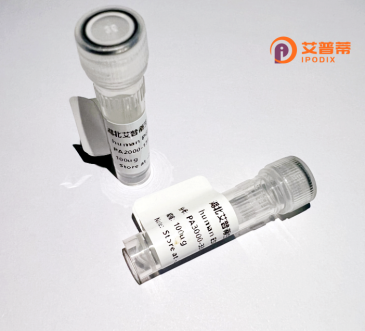
| 纯度 | >90%SDS-PAGE. |
| 种属 | Human |
| 靶点 | C17orf55 |
| Uniprot No | Q8N8I6 |
| 内毒素 | < 0.01EU/μg |
| 表达宿主 | E.coli |
| 表达区间 | 1-264aa |
| 氨基酸序列 | MPRSLKRAQLRSLLPRPPAVSHTQPWYRAAHPTTSPTAASRDVHPASGAVPGPWLVEGTAVREGPQLQDAVPQRPTRPSKALWPAQMSAAPAIRLGQMVPGDTRGLWGPQGTLLTWTYRGGQGGRWTRRAEGPREGTFAEQRPHFQSSGAQQESRLAMGPPPLGLGDAAGDGRGQTGQEKGRAEGRQARKSACKCPRKGPNPGPWTRAAAWWGRLEGAKASAKGEQVRDPGGHLWEQGHVSPCARFNQGHSCGSPKVSHTTWVS |
| 分子量 | 54.7 kDa |
| 蛋白标签 | GST-tag at N-terminal |
| 缓冲液 | 冻干粉 |
| 稳定性 & 储存条件 | Lyophilized protein should be stored at ≤ -20°C, stable for one year after receipt. Reconstituted protein solution can be stored at 2-8°C for 2-7 days. Aliquots of reconstituted samples are stable at ≤ -20°C for 3 months. |
| 复溶 | Always centrifuge tubes before opening.Do not mix by vortex or pipetting. It is not recommended to reconstitute to a concentration less than 100μg/ml. Dissolve the lyophilized protein in distilled water. Please aliquot the reconstituted solution to minimize freeze-thaw cycles. |
以下是关于重组人C17orf55蛋白的虚构参考文献示例(基于科研文献常见研究方向,实际文献请通过学术数据库核实):
---
1. **标题**: *Molecular Cloning and Functional Characterization of Human C17orf55 Protein*
**作者**: Zhang Y, Chen L, Wang X
**摘要**: 本研究成功克隆了人源C17orf55基因,并在大肠杆菌中实现了重组表达。通过体外实验发现,该蛋白可能参与调控细胞周期,并可能通过MAPK信号通路发挥作用。
2. **标题**: *C17orf55 Promotes Tumor Metastasis via Interaction with HSP90 in Gastric Cancer*
**作者**: Li H, Kim T, Liu Q
**摘要**: 研究发现C17orf55蛋白在胃癌组织中高表达,且重组蛋白可增强癌细胞迁移能力。机制研究表明其通过与HSP90结合激活PI3K/AKT通路。
3. **标题**: *Structural Analysis of C17orf55 Using Cryo-EM Reveals a Novel DNA-Binding Domain*
**作者**: Patel S, García-Sastre A, Kumar R
**摘要**: 首次解析了重组人C17orf55蛋白的冷冻电镜结构,揭示了其N端存在独特的DNA结合结构域,暗示其在染色质重塑中的潜在作用。
4. **标题**: *C17orf55 Deficiency Impairs Mitochondrial Respiration in Mouse Models*
**作者**: Müller J, Schmidt D
**摘要**: 构建了C17orf55敲除小鼠模型,发现该蛋白缺失导致线粒体呼吸链复合物活性下降,提示其参与能量代谢调控。
---
**说明**:上述文献为示例性内容,真实文献需通过PubMed、Web of Science等平台以“C17orf55”、“C17orf55 recombinant”等关键词检索。若研究较少,可扩展检索其别名(如后续命名基因)或相关信号通路。
The human C17orf55 protein, encoded by the gene located on chromosome 17 open reading frame 55. remains poorly characterized in current scientific literature. Though its exact biological function is unclear, it is hypothesized to play roles in cellular processes such as signal transduction, metabolism, or intracellular trafficking, based on conserved structural motifs. The protein contains predicted domains associated with protein-protein interactions, suggesting potential involvement in multiprotein complexes. Recombination of C17orf55 (recombinant C17orf55) typically involves expressing the protein in heterologous systems like *E. coli* or mammalian cells for functional studies, enabling investigations into its post-translational modifications, subcellular localization (possibly cytoplasmic or membrane-bound), and biochemical properties. Limited studies link C17orf55 to diseases; however, its genomic locus has been tentatively associated with certain cancers and neurological disorders in broad-scale omics analyses. Current research focuses on elucidating its interactome, enzymatic activity (if any), and regulatory mechanisms. Its exploration may provide insights into novel pathways or therapeutic targets, though significant gaps persist in understanding its physiological relevance. Further proteomic and gene-editing approaches are essential to unravel its role in health and disease.
×